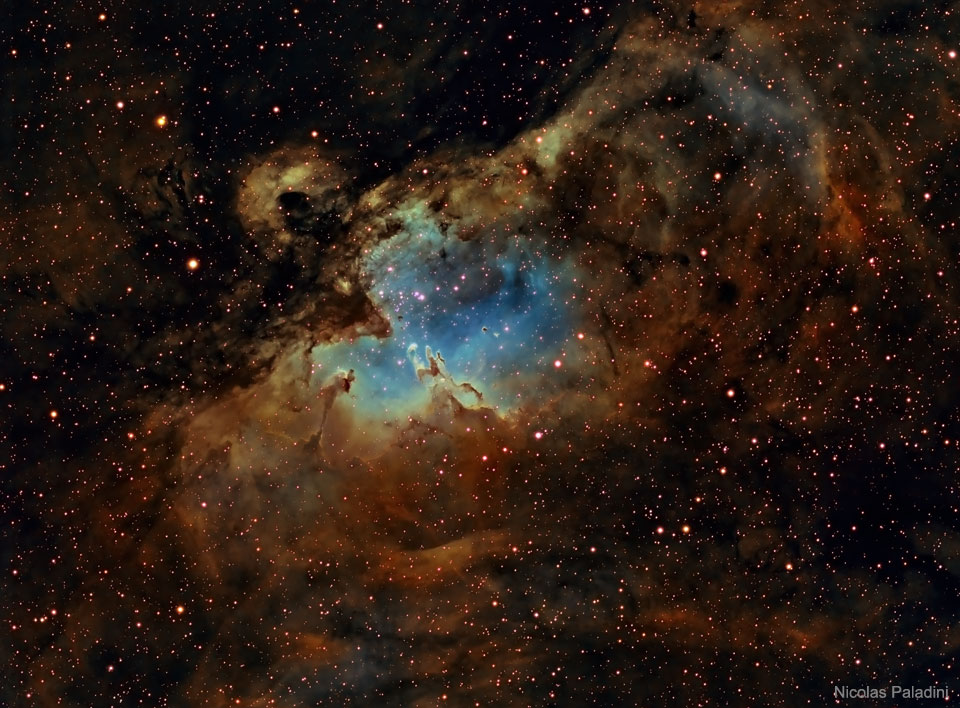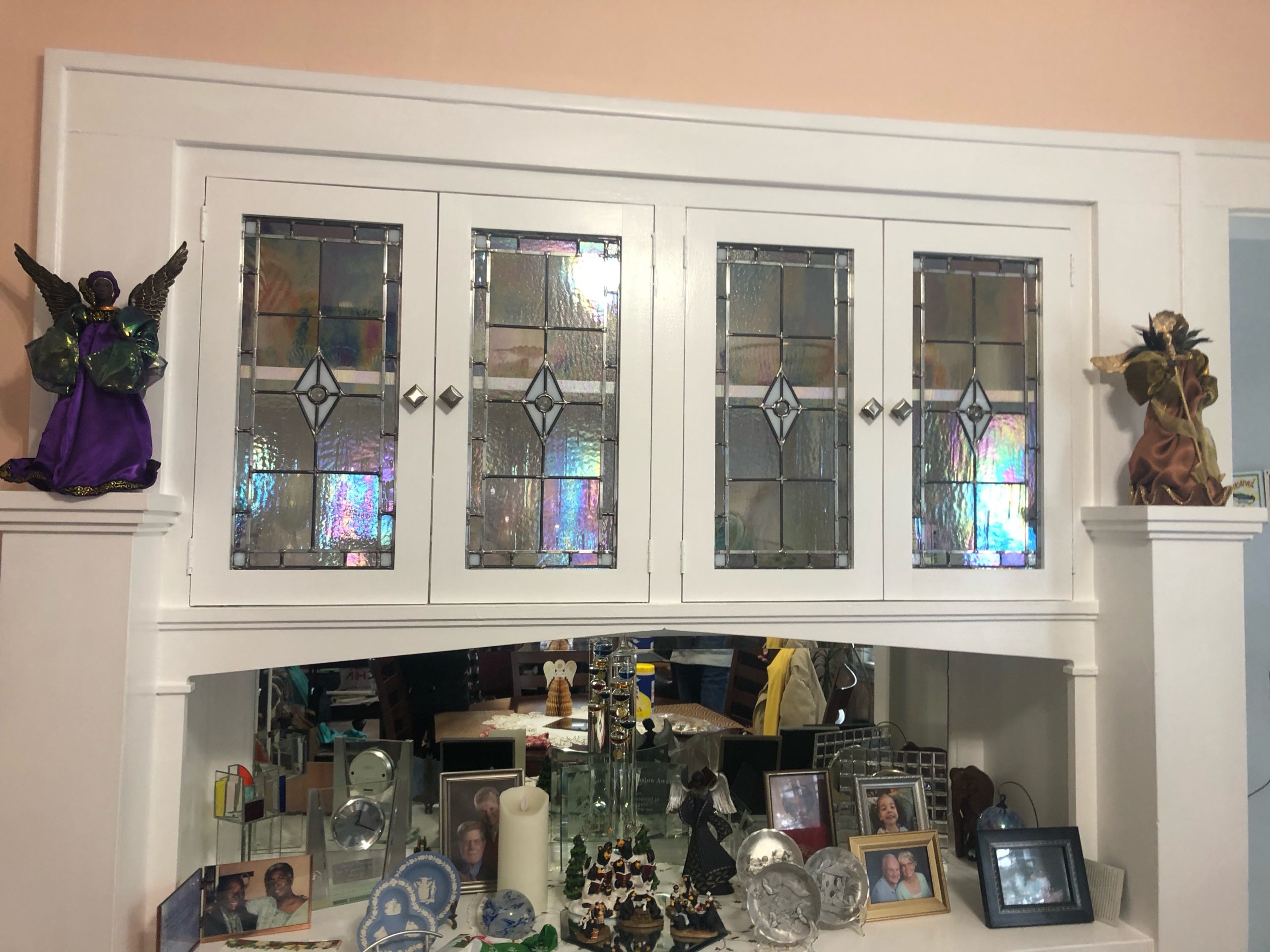Blog
This little blue nebula is so inconspicuous, it is often overlooked in favor of bigger and brighter nebulae. Found among a rich field of nebulae within the constellation of Taurus, it’s extremely rare to see it isolated—let alone in such gloriously high-resolution.
Called Cederblad 30 (otherwise known as LBN 782, with LBN standing for Lynds Bright Nebula), this small fan-shaped region is classified as a reflection nebula, and given the dark underpinning of its surrounding—it’s like a glimmer of light in a smoky, black pit (it really, really is). Running around and through Cederblad 30 are numerous dark nebulae, which aren’t clear in this particular image.
I wasn’t able to find too much information about this one either (which seems to be happening a lot these days), but I did stumble upon something that talked about Cederblad 30 often being mistaken for IC 359, and the mix-up goes all the way back to the days in which Edwin Hubble was compiling his deep sky catalog.

Marianne Evelyn Gabriel Faithfull (born 29 December 1946) is an English singer, songwriter, and actress. She achieved popularity in the 1960s with the release of her hit single “As Tears Go By” and became one of the lead female artists during the British Invasion in the United States.
Born in Hampstead, London, Marianne Faithfull began her career in 1964 after attending a Rolling Stones party, where she was discovered by Andrew Loog Oldham. After the release of her hit single “As Tears Go By“, she became an international star. Her debut album Marianne Faithfull (1965) (released simultaneously with her album Come My Way) was a commercial success followed by a number of albums on Decca Records. From 1966 to 1970, she had a highly publicised romantic relationship with Mick Jagger. Her popularity was further enhanced by her film roles, such as I’ll Never Forget What’s’isname (1967), The Girl on a Motorcycle (1968), and Hamlet (1969). However, her popularity was overshadowed by personal problems in the 1970s. During that time she was anorexic, homeless, and a heroin addict.
Noted for her distinctive voice, Marianne Faithfull’s previously melodic and higher registered vocals (which were prevalent throughout her career in the 1960s) were affected by severe laryngitis, coupled with persistent drug abuse during the 1970s, permanently altering her voice, leaving it raspy, cracked and lower in pitch. This new sound was praised as “whisky soaked” by some critics for helping capture the raw emotions expressed in her music. After a long commercial absence, Marianne Faithfull made a comeback with the 1979 release of her critically acclaimed album Broken English. The album was a commercial success and marked a resurgence of her musical career. Broken English earned Faithfull a nomination for Grammy Award for Best Female Rock Vocal Performance and is often regarded as her “definitive recording”. She followed with a series of albums, including Dangerous Acquaintances (1981), A Child’s Adventure (1983), and Strange Weather (1987). Faithfull also wrote three books about her life: Faithfull: An Autobiography (1994), Memories, Dreams & Reflections (2007), and Marianne Faithfull: A Life on Record (2014).
Marianne Faithfull is listed on VH1‘s “100 Greatest Women of Rock and Roll” list. She received the World Lifetime Achievement Award at the 2009 Women’s World Awards and was made a Commandeur of the Ordre des Arts et des Lettres by the government of France.
more...Richard Clare Danko (December 29, 1943 – December 10, 1999) was a Canadian musician, bassist, songwriter and singer, best known as a founding member of The Band. During the 1960s, Danko performed as a member of the Hawks, backing Ronnie Hawkins and then Bob Dylan. Then, between 1968 and 1977, Danko and the Hawks, now called the Band, released seven studio albums before the band broke up. In the late 1990s, up until his death, Danko participated in the Band’s partial reunion.
It was Danko who found the pink house on Parnassus Lane in Saugerties, New York, which became known as Big Pink. Danko, Hudson, and Manuel moved in, and Robertson lived nearby. The Band’s musical sessions with Dylan took place in the basement of Big Pink, between June and October 1967, generating recordings that were officially released in 1975 as The Basement Tapes. In October, the Hawks began demo recordings for their first album, with Helm rejoining the group in that month. Their manager, Albert Grossman, secured them a recording deal with Capitol Records in late 1967.
From January to March 1968, the Band recorded their debut album, Music from Big Pink, in recording studios in New York and Los Angeles. On this album, Danko sang lead vocal on three songs: “Caledonia Mission”, “Long Black Veil” and “This Wheel’s on Fire.”
more...Joseph Salvatore Lovano (born December 29, 1952) is an American jazz saxophonist, alto clarinetist, flautist, and drummer. He has earned a Grammy Award and several mentions on Down Beat magazine’s critics’ and readers’ polls. He is married to jazz singer Judi Silvano with whom he records and performs. Lovano was a longtime member of a trio led by drummer Paul Motian.
Lovano was born in Cleveland, Ohio, United States, to Sicilian-American parents; his father was the tenor saxophonist Tony (“Big T”) Lovano. His father’s family came from Alcara Li Fusi in Sicily, and his mother’s family came from Cesarò, also in Sicily. In Cleveland, Lovano’s father exposed him to jazz throughout his early life, teaching him the standards, as well as how to lead a gig, pace a set, and be versatile enough to find work. Lovano started on alto saxophone at age six and switched to tenor saxophone five years later. John Coltrane, Dizzy Gillespie, and Sonny Stitt were among his earlier influences. After graduating from Euclid High School in 1971, he went to Berklee College of Music, where he studied under Herb Pomeroyand Gary Burton. Lovano received an honorary doctor of music degree from the college in 1998.
more...Matthew Tyler Murphy (December 29, 1929 – June 15, 2018), known as Matt “Guitar” Murphy, was an American blues guitarist. He was associated with Memphis Slim, The Blues Brothers and Howlin’ Wolf. Murphy was born in Sunflower, Mississippi, and was educated in Memphis, Tennessee, where his father worked at the Peabody Hotel. Murphy learned to play guitar when he was a child.
In 1948, Murphy moved to Chicago, where he joined the Howlin’ Wolf Band, which at the time featured Little Junior Parker. In 1952, Murphy recorded with Little Junior Parker and Ike Turner, resulting in the release, “You’re My Angel”/“Bad Women, Bad Whiskey”(Modern 864), credited to Little Junior Parker and the Blue Flames.
Murphy worked often with Memphis Slim, including on his debut album At the Gate of Horn (1959). Murphy recorded two albums with Chuck Berry and was also featured in works by Koko Taylor, Sonny Boy Williamson II, Buddy Guy, Etta James, and Otis Rush. He also performed with Willie Dixon. He gave a memorable performance in 1963 on the American Folk Blues Festival tour of Europe with his “Matt’s Guitar Boogie”. Freddie King is said to have once admitted that he based his “Hide Away” on Murphy’s playing during this performance.
more...From afar, the whole thing looks like an Eagle. A closer look at the Eagle Nebula, however, shows the bright region is actually a window into the center of a larger dark shell of dust. Through this window, a brightly-lit workshop appears where a whole open cluster of stars is being formed. In this cavity tall pillars and round globules of dark dust and cold molecular gas remain where stars are still forming. Already visible are several young bright blue stars whose light and winds are burning away and pushing back the remaining filaments and walls of gas and dust. The Eagle emission nebula, tagged M16, lies about 6500 light years away, spans about 20 light-years, and is visible with binoculars toward the constellation of the Serpent (Serpens). This picture involved over 12 hours of imaging and combines three specific emitted colors emitted by sulfur (colored as red), hydrogen (yellow), and oxygen (blue).

Michel Petrucciani (French pronunciation: [miʃɛl petʁutʃani]; Italian: [petrutˈtʃaːni]; 28 December 1962 – 6 January 1999) was a French jazz pianist. From birth he had osteogenesis imperfecta, a genetic disease that causes brittle bones and, in his case, short stature. He became one of the most accomplished jazz pianists of his generation despite having pain in his arms. Michel Petrucciani came from an Italo-French family (his grandfather was from Naples) with a musical background. His father Tony played guitar, his brother Louis played bass, and his brother Philippe also plays the guitar. Michel was born with osteogenesis imperfecta, which is a genetic disease that causes brittle bones and, in his case, short stature. It is also often linked to pulmonary ailments. The disease caused his bones to fracture over 100 times before he reached adolescence and kept him in pain throughout his entire life. “I have pain all the time. I’m used to having hurt arms,” he said In Michel’s early career, his father and brother occasionally carried him because he could not walk far on his own unaided. In certain respects he considered his disability an advantage, as he got rid of distractions like sports that other boys tended to become involved in. And he hints that his disability was helpful in other parts of his life. He said: “Sometimes I think someone upstairs saved me from being ordinary.”
more...Lonnie Liston Smith Jr. (born December 28, 1940) is an American jazz, soul, and funk musician who played with such jazz artists as Pharoah Sanders and Miles Davis before forming Lonnie Liston Smith and the Cosmic Echoes, recording a number of albums widely regarded as classics in the fusion, smooth jazz and acid jazz genres.
Smith was born and raised in Richmond, Virginia, United States to a musical family; his father was a member of Richmond Gospel music group The Harmonizing Four, and he remembered groups such as the Swan Silvertones and the Soul Stirrers (featuring a young Sam Cooke) as regular visitors to the house when he was a child. He studied piano, tuba and trumpet in high school and college before receiving a B.S. in music education from Morgan State University in Baltimore in 1961. Smith has cited Charlie Parker, John Coltrane and Miles Davis as major influences in his youth. While still a teenager, Smith became well known locally as a backing vocalist as well as pianist in the Baltimore metropolitan area. During this period, he regularly performed with a number of his contemporaries, including Gary Bartz (alto), Grachan Moncur (trombone), and Mickey Bass (bass). He also backed a number of jazz singers (including Ethel Ennis) while performing in the house band at Baltimore’s Royal Theater shortly after receiving his degree.
more...Charles Neville (December 28, 1938 – April 26, 2018) was an American R&B and jazz musician best known as part of The Neville Brothers. Known onstage as “Charlie the horn man”, his saxophone playing helped earn the group a Grammy Award for best pop instrumental performance.
The second oldest of the four Neville brothers, Charles Neville was born in New Orleans on Dec. 28, 1938 to Arthur Lanon Neville Sr. and Amelia (Landry) Neville and was raised in the Calliope housing project with his musical brothers, Art, Aaron, and Cyril. Their uncle, George “Big Chief Jolly” Landry, was lead singer of the Mardi Gras Indian group The Wild Tchoupitoulas. Charles left home when he was 15 to play saxophone with the Rabbit’s Foot Minstrel Show. When back in New Orleans, he played in the house band at the Dew Drop Inn.
He served in the Navy from 1956 to 1958 and discovered the music scene on Beale Street while stationed in Memphis, Tennessee, later touring with B.B. King and Bobby (Blue) Bland.[1][2]
He joined the band of fellow New Orleanian Larry Williams, but his addiction to heroin landed him short jail terms for the shoplifting that sometimes supported his habit. He finally overcame his addictions in 1986. Beginning in 1963 he served three and a half years at Louisiana State Penitentiary at Angola for possession of marijuana. He practiced in the prison music room with other incarcerated New Orleans musicians, notably pianist James Booker and drummer James Black. Moving to New York City after release from prison, he explored modern jazz and toured with Johnnie Taylor, Clarence Carter, and O. V. Wright.
In 1976 he returned to New Orleans when his maternal uncle, George “Big Chief Jolly” Landry, called Charles and his brothers Art, Aaron, and Cyriltogether to record with his Mardi Gras Indian group, The Wild Tchoupitoulas. The blend of traditional and funk music on The Wild Tchoupitoulas album(1976) has made it an icon of New Orleans musical culture.
more...Edmund Leonard Thigpen (December 28, 1930 – January 13, 2010) was an American jazz drummer, best known for his work with the Oscar Peterson trio from 1959 to 1965. Thigpen also performed with the Billy Taylor trio from 1956 to 1959.
Born in Chicago, Illinois, Thigpen was raised in Los Angeles and attended Thomas Jefferson High School, where Art Farmer, Dexter Gordon and Chico Hamilton also attended. After majoring in sociology at Los Angeles City College, Thigpen returned to East St. Louis for one year to pursue music while living with his father who had been playing with Andy Kirk‘s Clouds of Joy. His father, Ben Thigpen, was a drummer who played with Andy Kirk for sixteen years during the 1930s and 1940s.
Thigpen first worked professionally in New York City with the Cootie Williams orchestra from 1951 to 1952 at the Savoy Ballroom. During this time he played with musicians such as Dinah Washington, Gil Mellé, Oscar Pettiford, Eddie Vinson, Paul Quinichette, Ernie Wilkins, Charlie Rouse, Lennie Tristano, Jutta Hipp, Johnny Hodges, Dorothy Ashby, Bud Powell, and Billy Taylor.
In 1959 he replaced guitarist Herb Ellis in the Oscar Peterson Trio in Toronto, Ontario, Canada. In 1961 he recorded in Los Angeles, featuring on the Teddy Edwards–Howard McGhee Quintet album entitled Together Again for the Contemporary label with Phineas Newborn Jr. and Ray Brown. After leaving Peterson, Thigpen recorded the album Out of the Storm as a leader for Verve in 1966. He then went on to tour with Ella Fitzgerald from 1967 to 1972.
more...Earl Kenneth Hines, also known as Earl “Fatha“ Hines (December 28, 1903 – April 22, 1983), was an American jazz pianist and bandleader. He was one of the most influential figures in the development of jazz piano and, according to one source, “one of a small number of pianists whose playing shaped the history of jazz”.
The trumpeter Dizzy Gillespie (a member of Hines’s big band, along with Charlie Parker) wrote, “The piano is the basis of modern harmony. This little guy came out of Chicago, Earl Hines. He changed the style of the piano. You can find the roots of Bud Powell, Herbie Hancock, all the guys who came after that. If it hadn’t been for Earl Hines blazing the path for the next generation to come, it’s no telling where or how they would be playing now. There were individual variations but the style of … the modern piano came from Earl Hines.”
The pianist Lennie Tristano said, “Earl Hines is the only one of us capable of creating real jazz and real swing when playing all alone.” Horace Silversaid, “He has a completely unique style. No one can get that sound, no other pianist”. Erroll Garner said, “When you talk about greatness, you talk about Art Tatum and Earl Hines”. Count Basie said that Hines was “the greatest piano player in the world”. Earl Hines was born in Duquesne, Pennsylvania, 12 miles from the center of Pittsburgh, in 1903.
more...Cheryl Davisdon’s Hutch is finally finished with White Squall window set via LaBriola Glass Art Studio. And she and wife are ecstatic about them. I’m so thrilled!

More Posts
- World Music Cumar Dhuule
- Daily Roots Dennis Brown
- Alien Spaceships Circling Earth
- Challenge to Change
- Cosmo NGC 4945
- Jorge López Ruiz
- Alberta Hunter
- Gilbert Scott-Heron
- Duke Jordan
- World Music Faysal Cumar Mushteeg Ahun
- Daily Roots Tommy McCook Supersonics
- Ahmed Yusuf & Somali Blues Performance 4-6-2025
- Don’t Lose Your Head
- Protect Our Children
- Introspection
- Canadian Solidarity
- Cosmo NGC 4941
- Joseph Haydn
- Johann Sebastian Bach
- Herb Alpert